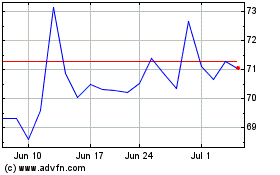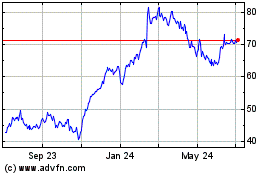Uber Tests Feature Allowing Some California Drivers to Set Fares
January 21 2020 - 1:01PM
Dow Jones News
By Preetika Rana
SAN FRANCISCO -- Uber Technologies Inc. is testing a new feature
that allows some drivers in California to set their fares, the
latest in a series of moves to give them more autonomy in response
to the state's new gig-economy law.
Starting Tuesday morning, drivers who ferry passengers from
airports in Santa Barbara, Palm Springs and Sacramento can charge
up to five times the fare Uber sets on a ride, according to a
person involved in developing the feature. Uber confirmed in an
emailed statement that it is doing an "initial test" that "would
give drivers more control over the rates they charge riders."
The ride-hailing giant has made many changes to the way it works
in response to California's passage of Assembly Bill 5. The law
requires companies to treat workers as employees -- eligible for
sick days and other benefits -- rather than independent contractors
if they are controlled by their employer and contribute to its
usual course of business. Uber has argued that it is a technology
platform that connects riders with drivers, not a transportation
company, so the drivers aren't part of its usual course of
business.
At least two lawsuits have been filed in federal court alleging
that Uber misclassified drivers, citing the law, which took effect
Jan. 1. Separately, the lawmaker who wrote AB5 has urged attorneys
in some of California's biggest cities to enforce the statute.
The fare test and other recent changes are part of Uber's effort
to strengthen its case that its drivers operate with some degree of
independence. Earlier this month, Uber capped its commissions on
rides across California. Last month, it allowed drivers in the
state to see where riders were going, letting them choose the trips
they wanted to take. Previously, drivers agreed to trips without
knowing the destination.
Uber's latest changes will set up a bidding system that lets
drivers increase fares in 10% increments, up to a maximum of five
times Uber's set price, the person involved in developing the
feature said. That price includes base fare, time spent and
distance covered by a driver. There is no limit on how often
drivers can raise prices. Once a rider pings the Uber app at the
locations in the pilot program, Uber will match the rider with the
driver who has set the lowest price, the person said. Drivers who
have set higher fares are gradually dispatched as more riders
request rides.
While the changes give drivers more autonomy, setting fares too
high could lead to fewer trips and longer waits. For riders, the
feature might result in higher fares and more volatility. Uber also
risks losing riders to rival Lyft Inc., which hasn't announced any
changes to its app in response to California's new gig-economy
law.
Starting next week, Uber plans to let drivers also set fares
lower than Uber's price. In addition to choosing a higher multiple,
drivers will be able to charge as little as one-tenth Uber's set
price, decreasing fares 10% at a time. They will also be allowed to
opt out of surge pricing.
"Drivers want to make more money, but now they're competing with
another driver for that money, so it's a lot more work and a lot
more confusing, " said Harry Campbell, a former Uber and Lyft
driver who runs a popular blog for drivers. "What happens if
drivers start setting fares lower and lower just so they can get
rides?"
The test program also doesn't account for quality, Mr. Campbell
said, because it doesn't give drivers with better ratings the
ability to charge the higher price, as would typically be the case
in a free marketplace.
Lawyers say allowing drivers to choose the trips they want to
take and set fares on them strengthens one of the three
requirements Uber must meet to avoid reclassifying drivers as
employees: that they are free from the company's control.
"It could be a game-changer for that," said Dan Handman, a
partner specializing in labor and employment law at Hirschfeld
Kraemer LLP's Los Angeles office. "But whether or not they can also
use this to show that drivers are outside their normal course of
business is questionable."
By testing the new feature in smaller cities, Uber wants to
limit any potential damage to its business, said the person who
worked on the feature. Uber will use feedback from the initial
rollout to determine whether to broaden the measure statewide, the
person said.
Lyft, DoorDash Inc. and Postmates Inc. have raised more than
$110 million for a planned ballot initiative this year, asking that
voters exempt them from AB5. The ballot measure also includes
several guarantees to ride-hailing and delivery drivers that
coalition members say don't currently exist, such as giving drivers
30 cents for each mile driven to account for gas and other vehicle
costs, health-care subsidies for drivers who work 15 hours or more
a week and occupational-accident insurance coverage while on the
job.
Uber and Postmates also sued California to challenge the
legislation. The food-delivery rivals joined two drivers in the
lawsuit filed in federal court last month. The suit claims that the
law violates constitutional guarantees of equal protection because
of how it targets some workers and companies.
--Eliot Brown contributed to this article.
Write to Preetika Rana at preetika.rana@wsj.com
(END) Dow Jones Newswires
January 21, 2020 12:46 ET (17:46 GMT)
Copyright (c) 2020 Dow Jones & Company, Inc.
Uber Technologies (NYSE:UBER)
Historical Stock Chart
From Mar 2024 to Apr 2024

Uber Technologies (NYSE:UBER)
Historical Stock Chart
From Apr 2023 to Apr 2024
